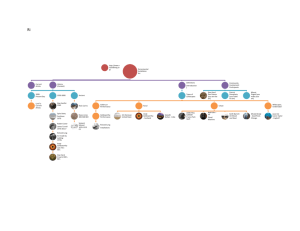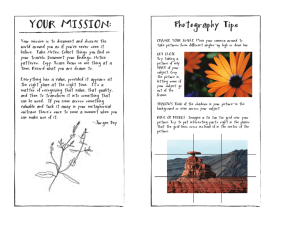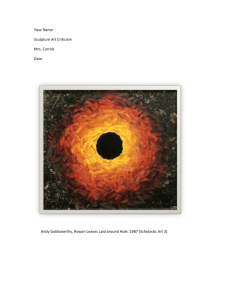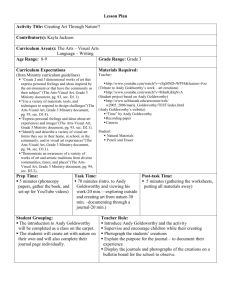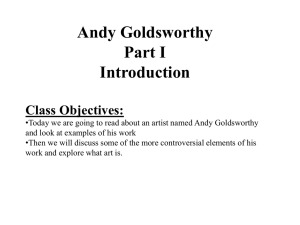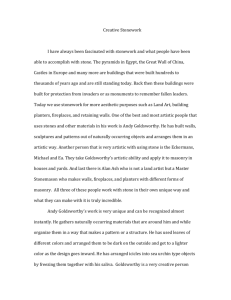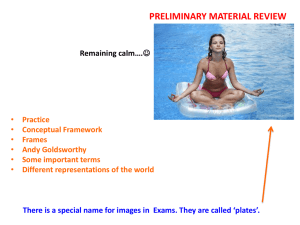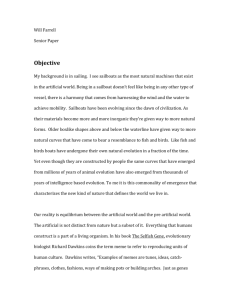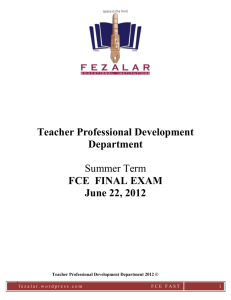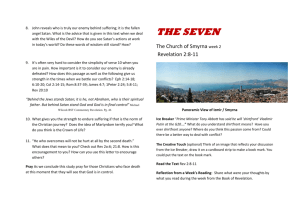A Touch of Nature - Molesworth Primary School
advertisement
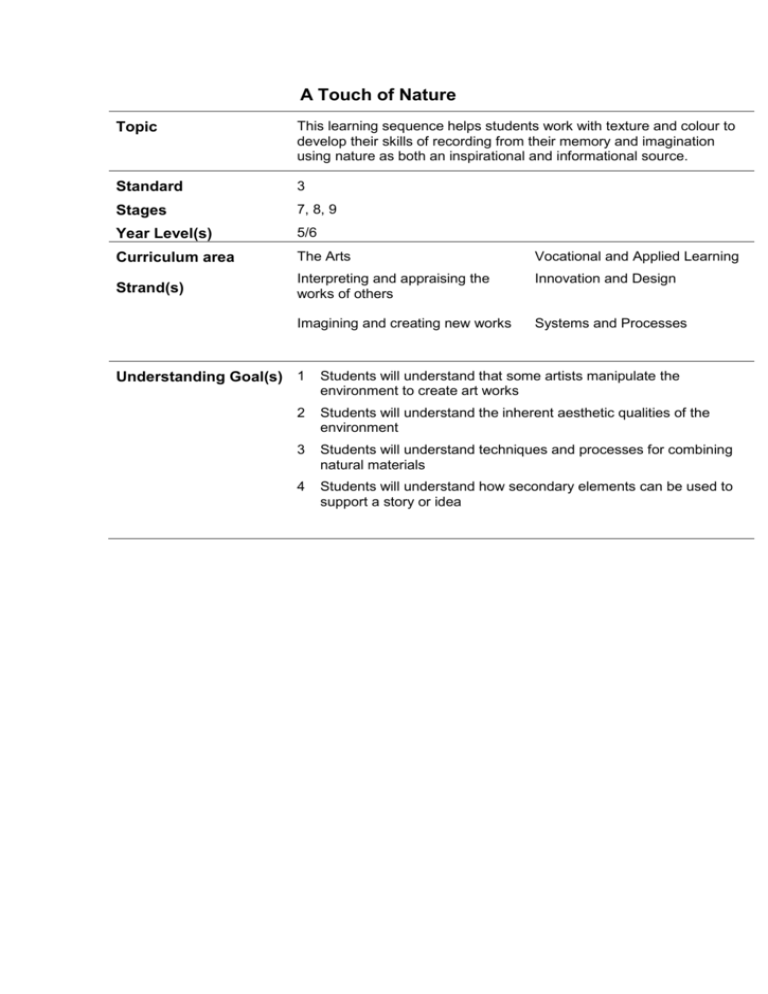
A Touch of Nature Topic This learning sequence helps students work with texture and colour to develop their skills of recording from their memory and imagination using nature as both an inspirational and informational source. Standard 3 Stages 7, 8, 9 Year Level(s) 5/6 Curriculum area The Arts Vocational and Applied Learning Strand(s) Interpreting and appraising the works of others Innovation and Design Imagining and creating new works Systems and Processes Understanding Goal(s) 1 Students will understand that some artists manipulate the environment to create art works 2 Students will understand the inherent aesthetic qualities of the environment 3 Students will understand techniques and processes for combining natural materials 4 Students will understand how secondary elements can be used to support a story or idea UGs 1, 2 1 Learning opportunities Teacher notes and assessment Ancient forms Brainstorm with students some examples where the environment has been manipulated e.g. Crop circles Easter Island figures Cairns (bushwalking markers) Native Canadian stone figures Beehive huts, Dingle Bay, Ireland Totem poles Maori greeting houses Mount Rushmore Abu Simbel The city of Petra Mayan ziggurats Terraced rice paddies Stone Henge Assessment for learning Have students explore natural construction forms e.g. Termites nests Stalactites and stalagmites Beehive Cobwebs Birds nests Cocoons Coral Shells Eggs Tessellations and other geological formations Assessment of learning Environmental Art Discuss with students the genre of landscape/environmental art, showing them some images of artists such as Richard Long….. Assessment of learning Discuss with students the importance of making art works that respect the integrity of the environment and its inhabitants. As a class, model the thinking technique of ‘I see, I think, I wonder’ using a picture of a manipulated environment. Give students a similar picture as a stimulus for creating their own ‘I see, I think, I wonder’ How has the landscape been manipulated to create a monument or structure? What has motivated people to create such things? Have students describe the natural structure they have researched through journal notes and drawings. What structures have been created? What makes these structures efficient? Assess student understanding of the genre of environmental art through class discussion. How does the environment inspire these artists? Why have artists chosen the landscape to express their ideas? 1, 2, 3 Andy Goldsworthy Share Andy Goldsworthy’s work with the class. Make a list of the materials and techniques that Goldsworthy has incorporated into his sculptures e.g.: Leaves Stones Tree branches Ice Twigs Bark Rushes Grasses Petals Pine needles Thorns Have students read Goldsworthy’s free verse that he has developed to describe his work. 2, 3, 4 Molesworth Environment Centre: Ask students to describe the landscape, making a list of key words to describe their sensory experiences i.e. light, texture, temperature, smell, colour, contrast, sound, brightness... Re-visit Goldsworthy’s work with students and ask then to construct ephemeral sculptures made from materials they have found on the trail. Assessment as learning Have students describe in their journals the structures, materials and techniques that Goldsworthy has used to create environmental works. Note to the teacher: Have students record these words in their journal, sorting words in order of importance. Some simple strategies can be used to encourage text construction e.g.: Free verse Haiku Acrostic Explain that these sculptures are installations, therefore students need to consider the sculpture’s relationship to its surroundings and that they will demonstrate their awareness of this relationship by documenting the installation using photography. 1, 2, Exhibition Assessment of learning 3, 4 Have students produce their photographic images and display them with written captions, in the style of Andy Goldsworthy. Organise an exhibition of student works, Have students photograph their work, making decisions about composition – foreground/background/ depth with invitations, refreshments and a guest speaker. of field, contrast, colour… Have students make written notes describing the place, the materials, the weather conditions and how the pieces were attached to each other. How have I arranged my work? What materials were used? How does this work fit in with its surroundings? 1, 2 Extension Activities Assessment of learning 3, 4 Explore how to make hand made paper incorporating found natural objects – leaves, fronds, petals, moss, grasses, lichen, seeds, feathers… Assess student understanding of: The way artists manipulate the environment to create art work The inherent aesthetic qualities of the environment Construct woven animals, nature puppets and fish weavings using materials such as bracken, twine and cane. techniques and processes for combining natural material Explore soundscapes with students. Ask students to collect and replicate a variety of sounds from the environment – i.e. bird calls, people talking, weather patterns... Allow students to experiment with instrumentation both conventional and student designed e.g. drums, ocarinas… How secondary elements (sound, photography, free verse) can be used to support a story or idea Demonstrate natural dyeing techniques using natural materials e.g. gum leaves, bracken and bark (these may be supplemented with things like onion skins, beetroot and red cabbage). Create a small book of student works, describing their visit to Molesworth Environment Centre. Resources Kastner, J. (Editor) and Wallis, B (2005) Land & Environmental Art (Themes & Movements), Phaidon Goldsworthy, A. (1994) Andy Goldsworthy, Viking Studio Goldsworthy, A (1990) Andy Goldsworthy: A Collaboration with Nature Harry N. Abrams Goldsworthy, A. (2007) Enclosure Abrams Books Goldsworthy, A, (1996) Wood Harry N. Abrams Goldsworthy, A. (1994) Stone Harry N. Abrams Goldsworthy, A., Baker, K. and Thompson, J. L. (2000) Wall: Andy Goldsworthy Thames and Hudson Goldsworthy, A. (2004) Passage Harry N. Abrams Goldsworthy, A. (2008) Time Abrams Goldsworthy, A. and Friedman, T. (2004) Hand to Earth Harry N. Abrams Goldsworthy, A. and Craig, D. (1999) Arch Harry N. Abrams
